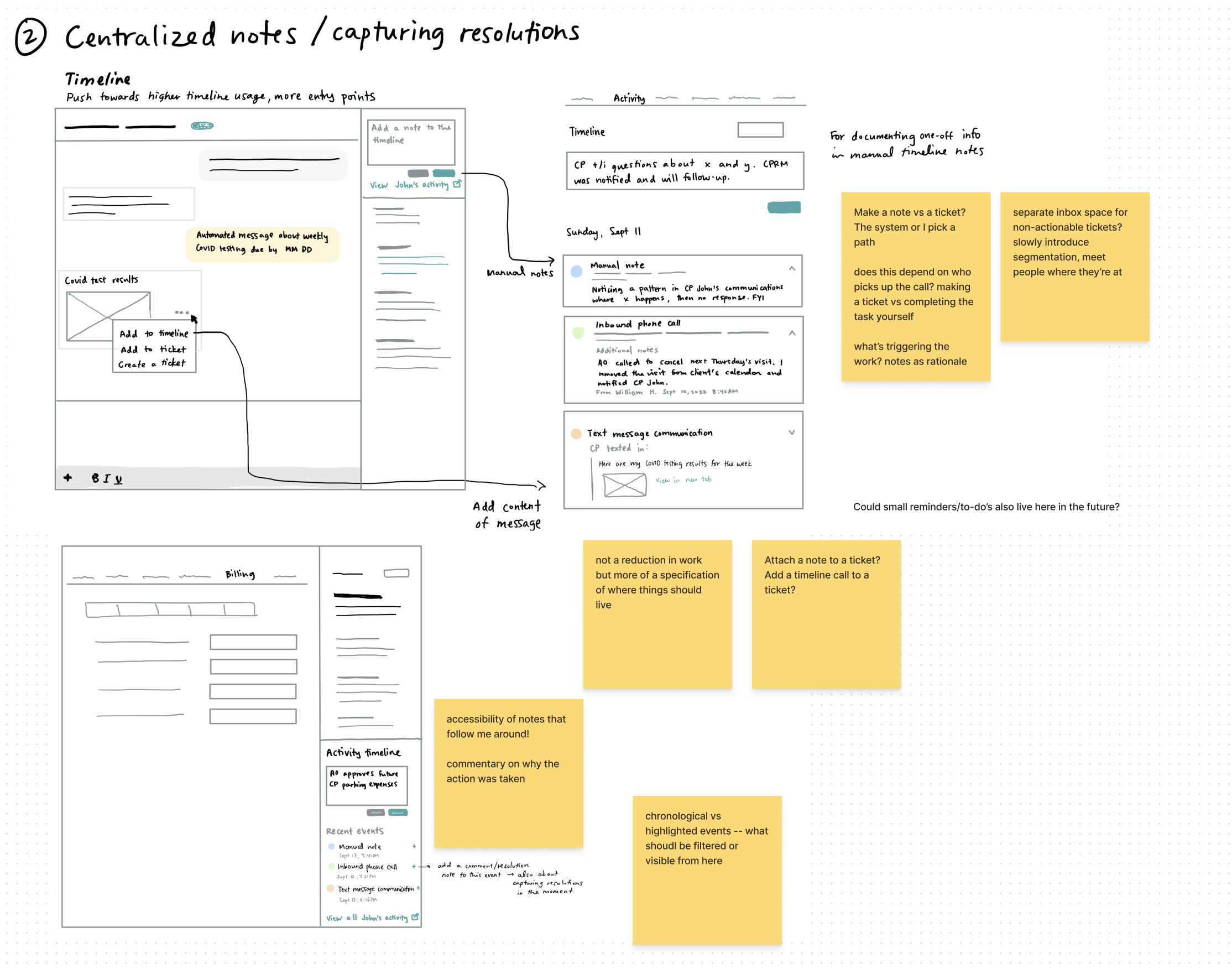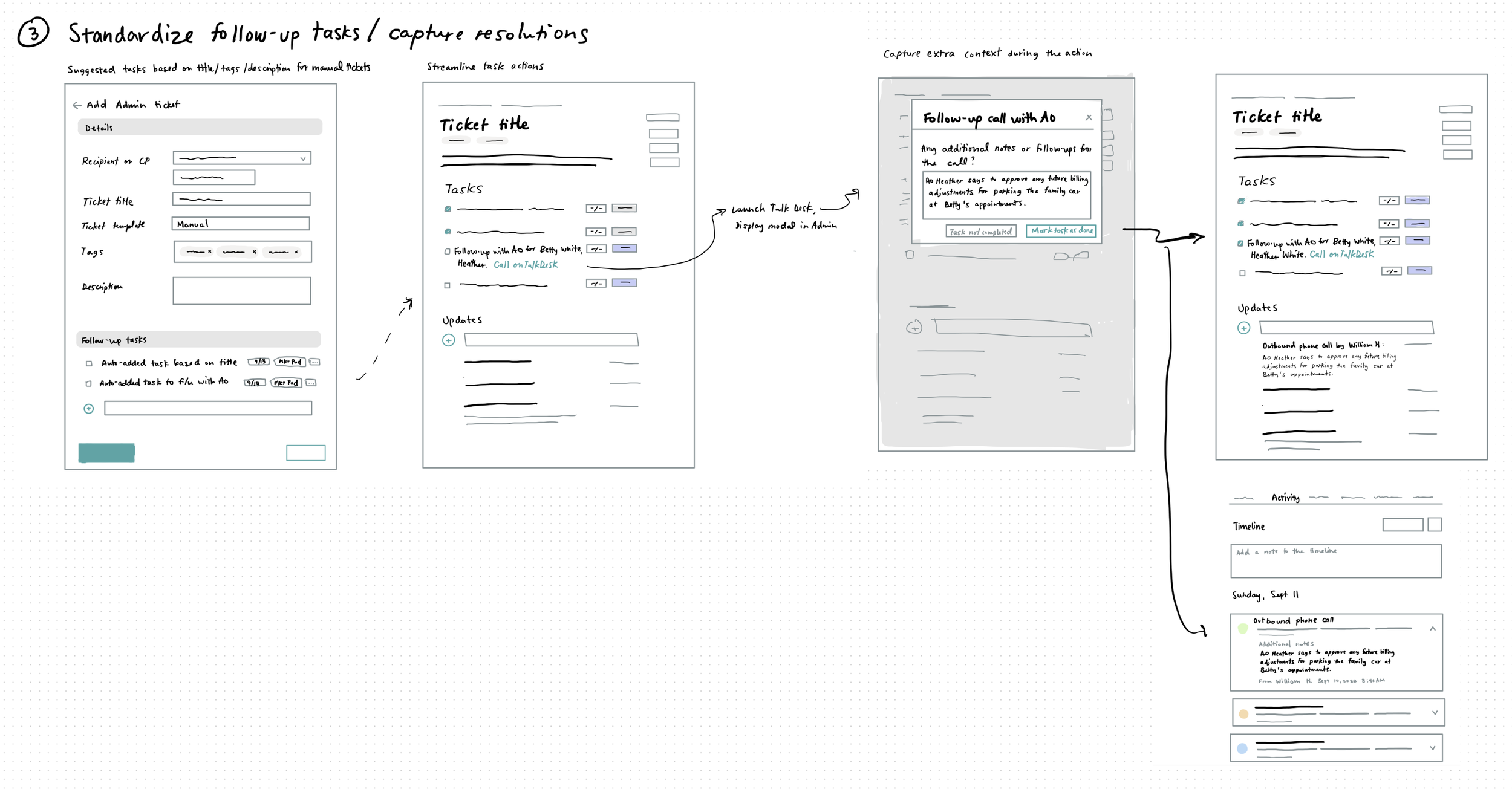Automated ticket management
Honor Technology
Aug - Nov 2022
Summary
Preview of select screens
Lead designer working with PM, 3 engineers, the internal process team, and our operations team.
I designed a framework for introducing automations into ticketing to build trust between users and the system, collect structured data to better understand thresholds and reasoning behind manual sorts, and build the foundation for more complex sorting.
The automation reduces the operation teams’ time manually triaging and sorting their inbox, as part of a larger effort to decrease time in Tickets and overall reduce OpEx.
I conducted qualitative research with our ops team and presented findings and concepts to align our stakeholders to a unified future.
Background
Honor is a network and platform connecting clients, caregivers, and local agency owners to provide non-medical home care to aging adults. Honor’s operations team handles all visit logistics and customer service, and tickets in the administrative console are their primary mode of internal task tracking. Tickets are used for handling inbound issues from clients and caregivers, outbound tasks such as outreach and incident follow-up, or internal coordination across teams.
One of our pod’s key metrics was decreasing the operating expenses of the company. An audit of the operation team’s time showed that the ops team spends ~15% of their week in ticketing. I was tasked to own this product area and investigate how we might reduce this and put more of this time towards client-facing activities.
Example of a ticket
Problems
I interviewed several roles across our operations team to understand ticket workflows around key areas such as triage, handoffs, managing a backlog of tickets, managing due dates, and documentation. The biggest opportunity area related to ticket triage: how the team prioritizes work and determines a ticket is ready to be worked on.
A portion of the research synthesis
If a ticket or any sub-task within it is assigned to an individual, it will show up in their inbox, resulting in a queue of hundreds of tickets. With such a large queue, the ops team spends a significant amount of time manually managing their and/or their team’s inbox daily, outside of the actual ticket work to be done. This might include triaging which tickets to prioritize, handing off tickets to another teammate, or pushing due dates for overdue tickets. Inbox management is made worse by what we identified as “non-actionable tickets”.
Non-actionable tickets do not require action from you right now or any action at all. Tickets can have sequential tasks that must first be completed by other people or teams. Some tickets must be completed on a future date, like a client check-in or reminder, and other tickets have no action needed at all and serve as an internal note. One client manager I spoke to had 190 tickets in her inbox, but after triaging, only 3 needed to be actively worked on for the day.
A flow diagram to classify tickets, based on interviews and inboxes
These non-actionable tickets add noise to their inbox and force them to re-triage and re-investigate each ticket daily to determine if something needs to get done today. This process relies on the ops team to constantly check for updates but also leads to the team leaning on their memory and various workarounds. This eventually results in work falling through the cracks and a poor experience for our clients and caregivers.
“I feel like we almost miss things because we're kind of ignoring the top half of our tickets because, oh, well, yeah, I've already seen that one.” — Regional manager
The ops team created workarounds and out-of-product solutions, but these have created more touch points and taken even more time out of the ops team’s day.
Top of one client manager’s inbox— only the 2 highlighted tickets are actionable today
Goals & metrics
If the system can identify and segment actionable versus non-actionable tickets, important tickets will be completed faster and are less likely to be overlooked while also reducing cognitive load for the ops team.
Success metrics
Reduce the number of low value touch points in critical work, with fewer people involved in each ticket as a proxy metric
Reduce time spent in tickets overall
Reduce number of overdue tickets
Business goals
Increase client satisfaction around issue resolution
Improve Care Platform economics
Solution
In the future, we see tickets becoming a personalized queue of work that tells you when a ticket is ready for your input, with many tasks and processes becoming automated. For this project, engineering work was scoped for 4-6 weeks, and we were dealing with a legacy ticketing system with considerable tech debt. We agreed as a team to start with managing a subset of non-actionable tickets in the existing inbox. In addition to reaching the success metrics above, specific goals for this solution include:
Serving the immediate need to stay on top of tickets and increase accountability
Building trust between the users and the system with a smaller automation and visibility into the logic, as a step towards the future
Visualizing the mental model and distinction between actionable and non-actionable tickets by creating different spaces for them
Some discarded ideas that didn’t make the cut due to higher effort and lower impact:



MVP solution
Tickets are divided into two tabs within the inbox— “Action items” and “Everything else”
New and existing tickets are automatically sorted into the “Everything else” tab if they are primarily for documentation (based on key words in ticket titles), if the due date is more than 90 days out, or if they are assigned to a known placeholder/dummy account
If any of the above attributes are changed, the system informs the user where the ticket has been moved and why.
The ops team can explicitly move tickets to or from either tab, and we gather additional data on why to improve the sorting logic.
This separate tab allows the ops team to audit the “Everything else” tab as they get used to this automation, though we anticipate the need to do this will decrease with time.
Modal after ticket creation to confirm sorting
New tab for non-actionable tickets
Toast to let the user know this was auto-sorted after pushing out the due date
Preventing manual ticket moves for priority tickets
Results and next steps
The project was rolled out to a test group in Dec 2022 and fully rolled out in January 2023. Over a 4 week period post-launch, we noted that out of 1900 tickets auto-sorted, only 1 ticket was manually placed back into action items tab, affirming our initial sort parameters. The average time to close non-actionable tickets decreased by about 49%, or 131 days.
However, our target metrics showed little movement. Despite the mental footprint the non-actionable tickets occupied, they may not affect the time spent in the inbox drastically, as the remaining action item tickets still require heavy triage. In regard to the metric for reducing overdue tickets, often times tickets are overdue for reasons out of a team member’s control, such as waiting on a client or owner to complete a task.
Regardless, this phase of work was still critical to building out ticket automation infrastructure and building trust between the system and user, and we have a great sense of where to focus in the next phases:
Focus on the high volume of the other types of non-actionable tickets, i.e. those that are pending other work to be done first
Almost half of tickets are manually created, so we must continue to increase the use of ticket templates to standardize and enable system identification and automations
All ● Subscription edits ● Self-service rate editing ● Automated ticket management ● Sensor visualizations
